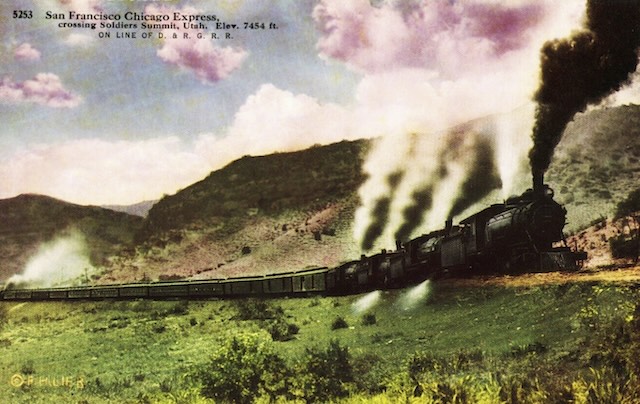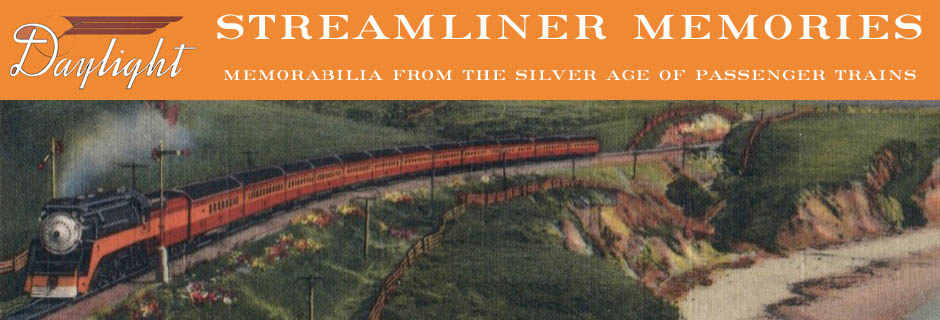This postcard says that it shows the eastbound San Francisco-Chicago Express climbing “Soldiers Summit.” The back spells it “Soldiers’ Summit,” but the modern-day spelling is “Soldier Summit.” The grade is so steep that five steam locomotives are required to haul ten passenger cars up to the summit. The postcard is marked “© F.H. Lieb,” referring to Frank H. Leib (whoever inscribed the copyright notice misspelled the name), a Salt Lake City photographer in the late 19th and early 20th centuries.

Click image to download a 1.2-MB PDF of this postcard.
The Denver & Rio Grande’s original grade up Soldier Summit was 4 percent, which is modest for an automobile but steep for a train. This was a major bottleneck for east-west traffic, so in 1913 Rio Grande opened a new route that made two switchbacks known as the Gilluly Loops, reducing the grade to 2.4 percent. The Google maps aerial photo below shows the loops and the original route, which is now followed by U.S. highway 6.

Click image for a larger view.
The original photo that was used for this postcard probably dates from before 1913. The photo for a second postcard was taken from a slightly different location where the rail line is straight rather than going around a corner. It dramatically shows that at least three of the locomotive safety valves have popped off (indicated by the white steam), revealing that the firemen are keeping boiler pressures as high as possible going up the grade.

Click image to download a 793-KB PDF of this postcard.
A third postcard appears to be based on the same black-and-white photo as the second one but in this case the artist who colored the original black-and-white photo did his or her best to highlight train detail, including a locomotive number that is either 1003, 1005, or 1008. The lead locomotive has also been highlighted to surprisingly show that it was a 4-6-2, as there is a wheel beneath the locomotive’s firebox.

Click image to download a 731-KB PDF of this postcard.
This is a surprise because the Rio Grande only owned six 4-6-2 locomotives, all of them purchased in 1913. The locomotives were built in January and the Gilluly Loops opened in November, so it is possible the photo was shot with the new locomotives on the old grade, but it seems unlikely.
To complicate matters, the Rio Grande owned not one, not two, but three series of steam locomotives that were numbered 1001 through 1006. This is because the Rio Grande was technically two different railroads at the time, the Denver & Rio Grande, which owned mostly tracks in Colorado, and the Rio Grande Western, which mostly owned the tracks in Utah.
The Rio Grande Western had a series of locomotives numbered 1101 through 1130 that, after the two railroads merged, were renumbered 1000 through 1029. But these were 2-8-0 locomotives, and none of the locomotives in these postcards fall into that category.
The Rio Grande Western also had a series numbered 1001 through 1010. Built in 1902, these were class 179 4-6-0 locomotives that, after the merger, were renumbered 750 through 759 and the class was renamed T-31. With 63″ driving wheels and 210 pounds of boiler pressure, these locomotives produced about 26,000 pounds of tractive effort.
The 4-6-2 locomotives, meanwhile, were owned by the Denver & Rio Grande. Originally numbered 1001 through 1006, they were renumbered 800 through 805 after the merger. As built they had 67″ drivers and 185 pounds of boiler pressure but produced more than 41,000 pounds of tractive effort. In 1924 their boilers were rebuilt to hold 200 pounds of pressure, boosting their tractive effort to well over 44,000 pounds.
The more powerful 4-6-2s allowed the Rio Grande to use one locomotive in many places where two 4-6-0s had been required. This suggests that only three would have been necessary up the 4 percent grade of Soldier Summit, if they ever actually operated on the 4 percent grade.
Thus, I’m pretty sure that all five steamers in all three postcards were 4-6-0 locomotives. The colorist of the third postcard probably added the extra wheel under the firebox just to make it appear more modern. If you want to see for yourself, you can compare the postcards with black-and-white photos of Rio Grande’s 4-6-2 and 4-6-0 locomotives in the Denver Public Library’s digital collection. In the latter case, focus on locomotives in the 1001-1010 or 750-759 number series.

Click image to download a 555-KB PDF of this postcard.
Finally, this postcard shows the grade up the Gilluly Loops with a photo taken from approximately the spot where the new line departed from the old one. The card shows three different passenger trains, at least two of which appear to be led by a single locomotive. A second plume of smoke behind the uppermost locomotive suggests that it may have had a pusher or that a fourth train is hidden behind the screen of trees. There isn’t enough detail to show what locomotives were used, but they were probably bigger than 4-6-0s.
All of these postcards are from after 1907, the year the Post Office began to allow people to write messages on postcard backs. I am roughly dating the first three postcards to 1910 plus or minus two years, though the one with the fake 4-6-2 is probably from around 1913. Because the last postcard refers to the Gilluly Loops as “new,” I’m dating it to 1915 plus or minus a couple of years.
